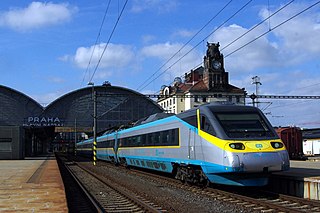
Transport in the Czech Republic relies on several main modes, including transport by road, rail, water and air.
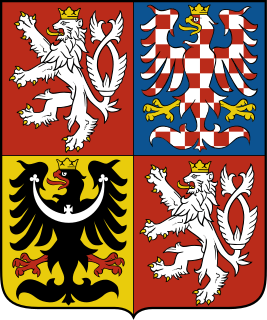
The Czech Republic elects a legislature at a national level. The Parliament has two chambers. The Chamber of Deputies has 200 members, elected for a four-year term by proportional representation with a 5% election threshold for political parties. The Senate has 81 members in single-seat constituencies, elected by two-round runoff voting for a six-year term, with one third of seats contested every even year in the autumn. The President of the Czech Republic was indirectly elected for five-year terms until 2012; beginning with the 2013 election, the president is elected by direct two-round runoff voting.

The Emperor Franz Joseph Railway was an Austrian private railway company, named after Emperor Franz Joseph I. It operated railway lines from the Austrian capital Vienna to Prague and Eger (Cheb) in Bohemia.

Beer has a long history in what is now the Czech Republic, with brewing taking place in Břevnov Monastery in 993. The city of Brno had the right to brew beer from the 12th century while Plzeň and České Budějovice, had breweries in the 13th century.

According to the 2010 census, there are around 3500 Muslims in the Czech Republic, compared to 495 in 1991. In 2016, there were an estimated 20,000 Muslims in the Czech Republic representing 0.2% of the country's population.
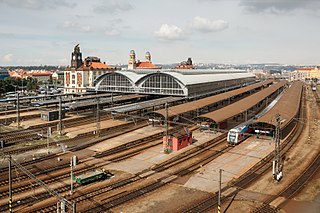
Praha hlavní nádraží is the largest and most important railway station in Prague in the Czech Republic. Located in Vinohrady, it was originally opened in 1871 and named Franz Josef Station after Franz Joseph I of Austria. During the First Republic and from 1945 to 1948 the station was called Wilson Station after former President of the United States, Woodrow Wilson. His statue stood in the park in front of the station before being torn down by German authorities when the U.S. entered the war in 1941. A new statue of Wilson was installed in 2012. In 2014, the station served 224,505 trains and every day it serves more than 100 000 passengers + additional 46 000 passengers using S-lines suburban trains

Referendums are held only occasionally by the Government of New Zealand. Referendums may be government-initiated or held in accordance with the Electoral Act 1993 or the Citizens Initiated Referenda Act 1993. Ten referendums have been held so far. Seven were government-led, and three were indicative citizen initiatives.

The European Parliament election of 2009 in Czech Republic was the election of the delegation from Czech Republic to the European Parliament in 2009. The Civic Democratic Party has won the election with a surprisingly strong lead against the Czech Social Democratic Party. Communist Party of Bohemia and Moravia came third and the Christian and Democratic Union – Czechoslovak People's Party became the last party to enter the Parliament.

A referendum on joining the European Union was held in the Czech Republic on 13 and 14 June 2003. The proposal was supported by 77.3% of voters, with a turnout of 55.2%. The Czech Republic joined the EU on 1 May 2004.

Svobodní is a classical liberal and right-libertarian, Eurosceptic political party in the Czech Republic. It was founded in 2009 by Petr Mach, an economist and professor of macroeconomics. Before assuming his position as a MEP, Mach taught economics at VŠFS, and VŠEM. The party is led by Tomáš Pajonk.

Eduard Ovčáček is a Czech graphic artist, sculptor, lettrist, painter and professor at the University of Ostrava. His main artistic focus is put on classical graphic art, visual and concrete poetry, serigraphic art (screen-print), collage, lettrist photography, evenements and installations, structural and digital graphic art. Paintings, sculptures and geometrical objects fall within his interest as well.
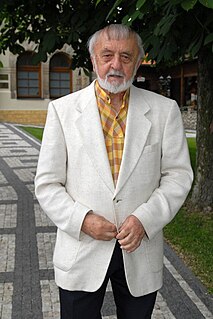
Dr. Jaroslav Brožek, CSc. is a Czech artist and professor of art, theorist in color theory, art teaching and methodologies. He has authored a number of publications about color and its effects on human perception, and together with other authors he prepared textbooks for primary schools as well as art schools in the Czech Republic.

Rail transport in the Czech Republic carried 162.906 million passengers and 68.37 million tonnes of cargo in the year 2009. The majority of passenger services run nowadays are operated by the state company České dráhy, which until 2007 also managed cargo services now run by ČD Cargo. In 2009 the country had 9,420 km of standard gauge track, 3,153 km of which is electrified. There are two main electrification systems in the Czech Republic, 3 kV DC in the northern part, and 25 kV 50 Hz AC in the south. Locomotives had to be changed on boundaries in the past, two-system locomotives has been introduced in 1974. The network has same gauge links to all four countries bordering the Czech Republic with passenger services to all four countries in operation. Major hubs for international passenger services on the network are in Prague, Ostrava, Brno and Břeclav, and the busiest station is Praha hlavní nádraží.

Praha-Vršovice railway station is a railway station located in Prague 4, located at the edge of Vršovice and Nusle, which carried 1,826,000 passengers in 2009. The station is located on the main line from Praha hlavní nádraží to České Budějovice, and the local line to Dobříš and Čerčany via Vrané nad Vltavou.

Strašnice is a cadastral district in Prague. It became part of Prague on 1 January 1922. It lies mostly in the municipal and administrative district of Prague 10 while a small part is in Prague 3. The district is bordered by Vršovice, Vinohrady, Žižkov, Malešice, Hostivař, Záběhlice and Michle.

Senate elections were held in the Czech Republic on 7 and 8 October 2016, with a second round on 14 and 15 of October. The first round was held alongside regional elections and several municipal referendums, notably in a referendum in Brno on the location of the town's train station.

Děčín hlavní nádraží is a railway station in the city of Děčín, Ústí nad Labem Region, Czech Republic. The station opened in 1850 and is located on the Děčín–Benešov nad Ploučnicí–Rumburk railway, Praha–Ústí nad Labem–Děčín railway, Děčín–Dresden-Neustadt railway and Děčín–Oldřichov u Duchcova railway. The train services are operated by České dráhy (ČD).
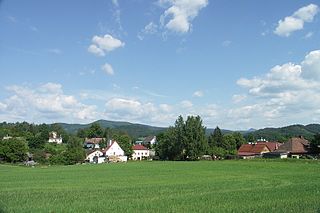
Rynoltice is a village and municipality (opec) in Liberec District in the Liberec Region of the Czech Republic. Rynoltice is 17 km west of Liberec.
























